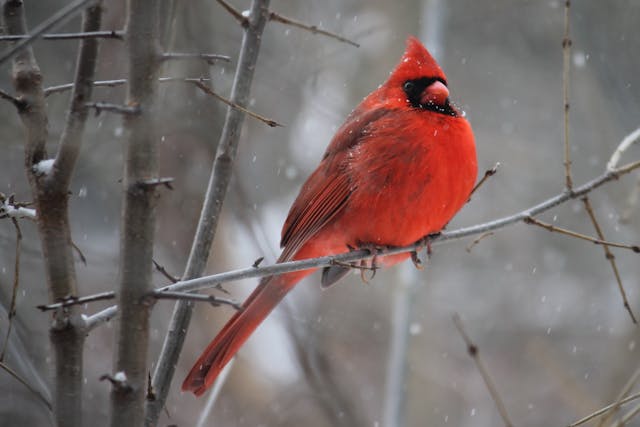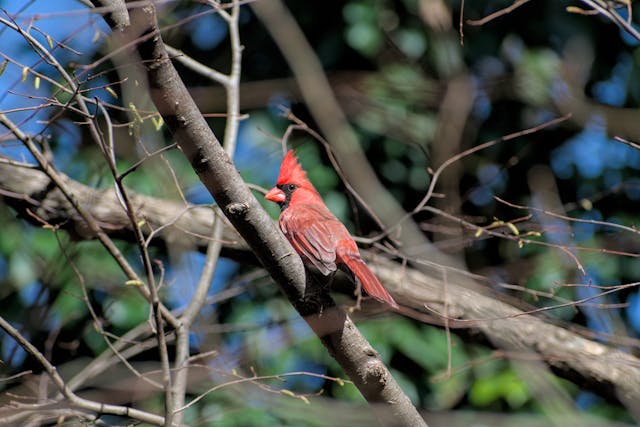Whenever wild birds visit your yard, it’s always exciting. When you encounter one of these birds sitting outside your window, cardinals are among the simplest to identify. Everywhere they fly, the males’ vivid red plumage makes them stand out. Males and females sing upbeat tunes and have jaunty crests resembling top hats.

Most rural and suburban locations in North America are home to cardinals. Since they don’t migrate, you may anticipate seeing them all year round. Here are some landscaping ideas that will attract cardinals, which are common yet lovely songbirds that you may welcome to your yard.
1. Plant the trees and shrubs that cardinals like.
Cardinals consume a lot of seeds. Even though they often visit feeders, the majority of their food comes from the natural world. Including some of the cardinals’ preferred seed sources in your yard can help to draw them in and encourage them to feed in your landscaping all year round. Planting native trees and bushes is a great strategy to draw in nearby birds. The cardinals have a fondness for mulberry, serviceberry, dogwood in bloom, crabapple, and spruce trees. The shrubs that are most popular with them for feeding include viburnum species, red-osier dogwood, gray dogwood, and staghorn sumac.
2. Build Layers Into Your Terrain
Cardinals often choose dense, twiggy plants as their nesting locations. A twig structure wrapped in a leafy mat coated with bark and grasses makes up their four-layer nests. Building these little works of art takes three to nine days. A variety of bushes will provide the busy birds an excellent combination of resources needed to build a house.

Make sure to include a few evergreen shrubs and trees, which the birds like in the winter, in addition to plants that shed their leaves in the autumn. To create a welcoming environment, group a few of these shrubs together close to the boundaries of your land. Selecting plants that serve as food sources for cardinals might quadruple your benefits.
3. Provide a Water Source
Cardinals are drawn to water, as are all backyard songbirds (ideally running water). Construct a bird bath yourself and include a little solar-powered fountain to maintain the water’s flow, or buy one that already has a fountain installed. Mosquitoes will be deterred from depositing their eggs in the water by the flowing water. Nevertheless, birdbaths need to be cleaned and refilled with new water on a daily basis. In frigid winter climates, a basic bird bath warmer will prevent the water from freezing solid.
4. Put up a feeder for birds
Cardinals aren’t picky about the kind of bird feeder they use. While a tube feeder is simple to fill and maintain, a platform feeder allows for easier bird observation. Use your favorite feeder, but pay attention to what ornithologists (bird experts) advise about placing the correct food in the feeder to attract cardinals. Cardinals are especially drawn to black oil sunflower seeds, according to studies. In addition, cardinals like eating peanut hearts, cracked maize, safflower, and hulled sunflower seeds.
How to Construct a Mason Jar Hummingbird Feeder at Home
Be advised that due of their enormous size and small, rounded wings, cardinals fly somewhat slowly. It’s best to keep your cats home while they’re on the ground gathering dropped seeds from feeders, since this makes them easy prey for cats. In addition, steer feeders clear of bushes and other plants that might serve as hiding places for other predators.
5. Motivate Caterpillars
While cardinals spend most of the year eating seeds and other plant components (they have been observed to devour the spring blossoms of redbud and forsythia), during the summer mating season, their diet changes to more protein-rich insects. Upon hatching, parents mostly feed their young soft caterpillars. By including a lot of caterpillar host plants in your garden beds and container plantings, such as dill, fennel, parsley, coneflowers, and milkweed, you may ease the burden on the birds. The host plants will have a few leaves munched by caterpillars, but before any real harm is done, cardinals will locate them.
The next best thing to not adding plants to your yard is to stay away from insecticides that kill caterpillars. Consider these bug larvae as vital nourishment for many other backyard birds, including cardinal chicks.

6. Allow Perennials to Survive the Winter
In winter, cardinals use the dried seed heads and leaves as a feeding ground; it’s not unusual to see a group of a dozen or more birds. Winter brings the birds together, yet during the mating season they usually graze alone or in pairs. When paired with adjacent shrubs, a substantial perennial stand will provide the flock with an invaluable source of food and shelter.
7. Offer Perches
Male cardinals often sing from tall tree perches. For smaller settings, choose trees with a columnar or narrow form, such arborvitae. These trees will spread out more than they rise, giving cardinals spaces to sing without invading surrounding vegetation or buildings.
Fun fact: The female northern cardinal sings more than most other songbirds in North America, and she usually does so while perched on the nest. Researchers think that by singing, she might be communicating with her partner when it’s time to deliver food to the nest.



